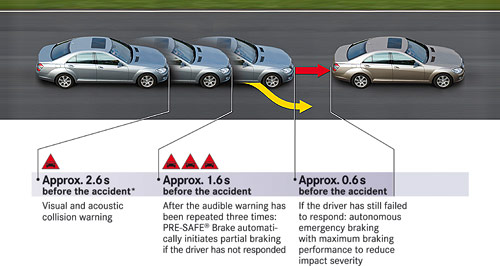Make / Model Search
News - Mercedes-BenzWe can slash road toll, says MercedesNight rider: Science fiction is fast becoming science fact, with cars of the near future being able to detect and avoid impending collisions. Benz expert says driving set to become safe as flying as new systems cut road risk11 Oct 2010 DRIVING a car could become as safe as flying in a passenger airliner within five to ten years, according to Mercedes-Benz Car’s vice-president of safety engineering Ulrich Mellinghoff. This would mean cutting road fatalities from the current one in 20,000 people to one in 100,000 - the same as air traffic, he said. Speaking in Melbourne, where he revealed new experimental crash safety systems that Mercedes expects will make it into the next generation of its luxury cars, Mr Mellinghoff said a zero road toll might be beyond the motor industry and roads authorities in the foreseeable future, but a much lower death rate was not only possible but expected.  From top: Braking bag, radar traffic scanner, night-vision camera, Mercedes-Benz Cars vice-president of safety engineering Ulrich Mellinghoff. From top: Braking bag, radar traffic scanner, night-vision camera, Mercedes-Benz Cars vice-president of safety engineering Ulrich Mellinghoff.He said systems such as car-to-car communication and radar-based crash avoidance would make the roads safer, even though the number of vehicles on global roads was expected to double to 1.3 billion vehicles by 2030. He said the world’s road users currently drove 32 trillion kilometers a year – a figure that would rocket to 70 trillion by 2050. Mr Mellinghoff said Australia and Germany not only had a similar road fatality rate per head of population but that the road toll had declined at a similar rate over the years as new safety measures came into play. He cited China – with its 180,000 road deaths last year – and the United States – with a fatality rate four times per head of population to ours – as examples of countries that could do much more to reduce road trauma. But he said even countries with leading road safety measures would be able to do much more with new car technologies and roads infrastructure. “About 4000 people are killed in Germany every year,” he said. “It is possible to think about 1000.” Mr Mellinghoff said Australia was not behind other countries in road safety, but there were still things that could be improved. He said one example of poor road design that he had spotted in his five days in Melbourne was highway guard rails that ended bluntly instead of angled into the ground, as in Germany. He also was critical of speeds limits, saying some urban speed limits of up to 80km/h were too fast while highway speed limits of 100km/h for passenger cars were too slow. “Maybe a top speed of 200 is not necessary, but if you divide it (the highway) a little bit on these very long distances you have to drive, it is better to drive at 130 or 140km/h than to drive at 100 and let trucks travel at 80 or 90km/h. “I think this would help to optimise the traffic.” Mr Mellinghoff said a passenger car could stop in the same distance from 120km/h as a truck took to stop from 80km/h, meaning trucks should travel slower. He dismissed the speed differential as a problem on divided highways, saying that in Germany, cars were only allowed to pass only on the outside lane and slower traffic had to stick to the slow lanes. “Therefore it can be handled, this speed differential,” he said. Mr Mellinghoff singled out mixing bicycles with motorised traffic and frequent tailgating by Australian drivers as other examples of unsafe practices that he said could be changed in Australia. While in Australia, Mr Mellinghoff was due to meet with representatives of the independent Australian New Car Assessment Program (ANCAP) to discuss forthcoming changes to the ratings system to incorporate the latest electronic crash avoidance assistance systems. ANCAP has already announced that it will adopt European NCAP advances in safety assessments for new cars, making it necessary to have advanced new systems to gain a five-star rating. Mr Mellinghoff said he would present Mercedes-Benz’s view on how such systems could be measured – a task that he said could be difficult. He said Mercedes-Benz had extensive experience in the development of such systems and was happy to help advise on the development of test protocols for world assessment programs, including those for NCAP and the United States National Highway Traffic and Safety Administration (NHTSA). Mr Mellinghoff resisted criticising the NCAP system for awarding five stars to today’s current crop of cheap cars – the same rating as a Mercedes-Benz S-class. He said the NCAP system had served world motorists well by driving up safety standards at a far faster rate than would otherwise have been the case. “But I think change is necessary because all the assistance systems that make it different to what we have now,” he said. “The current focus is on passive safety, but the new avoidance systems are the next phase of safety.” Mr Mellinghoff said car-to-car and car-to-infrastructure communications that would maximise crash avoidance might only be quickly and fully realised if governments rolled out the necessary infrastructure and then made such technology mandatory. “The next big step will be car to car-to-car or car-to-infrastructure communication,” he said. “It is a little bit difficult to introduce such a system because we need about 20 to 25 per cent of all cars to have car-to-car communications so the system works. “Maybe it is only possible if the government says ‘we want this’ and starts with the infrastructure.” Apart from ANCAP representatives, Mr Mellinghoff and his safety engineering experts were also meeting with various road safety researchers and academics from universities such as Monash, Sydney, Melbourne and the Royal Melbourne Institute of Technology during his visit.  Read more |
Click to shareMercedes-Benz articlesResearch Mercedes-Benz Motor industry news |










Facebook Twitter Instagram